As sargassum continues to wash up on Mexico’s Caribbean coast beaches, scientists warn there is a risk that the huge masses of seaweed could cause a health crisis.
Once sargassum leaves the ocean it emits sulfuric acid and arsenic, which not only threatens thousands of species of marine creatures but could also seep into Quintana Roo’s freshwater sources.
The warning comes from a group of 28 scientists from three universities who met last Thursday in the state capital of Chetumal, where they discussed strategies to control the seaweed’s environmental impact.
Large quantities of sargassum have been arriving on beaches in Quintana Roo since May and, at least in the short term, the smelly, brown seaweed looks set to continue showing up en masse.
A councilor from Solidaridad, the municipality where the resort city of Playa del Carmen is located, said the risk sargassum poses continues to increase.
“Satellite images obtained by the National Chamber of Commerce and Tourism Services this weekend showed offshore sargassum formations heading to the coast of Quintana Roo that are up to 10 times larger than those recorded until now,” Gustavo Maldonado said.
He added that according to scientists the seaweed does not come from the Sargasso Sea in the North Atlantic Ocean as originally thought but rather from the mouth of the Amazon River in Brazil.
Scientists say that global warming, ocean pollution and changing sea currents are all factors that contribute to the growing quantities of sargassum on Mexican beaches.
Marta García, a biologist and postdoctoral researcher at the National Autonomous University of México, added that it has also been discovered that formations of sargassum can double their biomass in less than 18 days, which she said “explains its rapid growth in coastal waters.”
Further complicating the problem is a new, more aggressive variety of sargassum developing off South America’s Atlantic coast due to the use of chemical products in agriculture in Brazil. Those products enter the ocean via the Amazon River.
In addition to the health and environmental risks the seaweed poses, the mass arrival of sargassum is affecting Quintana Roo’s tourism industry.
The state’s most famous and popular beaches in destinations including Cancún, Playa del Carmen, Tulum, Isla Mujeres, Cozumel and Holbox have been invaded by the seaweed, whose stench worsens in the heat and rain.
Quintana Roo Governor Carlos Joaquín González has asked the federal government to declare the state an emergency zone.
Brigitta Ine van Tussenbroek, a scientist at UNAM’s Institute of Marine Sciences and Limnology, said that dealing with the problem requires the creation of contingency plans that “reduce the impact on the natural ecosystem and tourist activities.”
Even after the sargassum is removed from beaches, sediments of the seaweed that remain on the sand and in shallow waters can continue to kill plants, marine creatures and other organisms that come into contact with them.
In response to the problem, the government of Quintana Roo is installing a system of containment booms to keep sargassum off the beaches.
The federal Environment Secretariat (Semarnat) has also acquired special machinery to remove the seaweed in the Caribbean Sea, but it won’t be delivered until November.
Earlier this month, Ine van Tussenbroek warned that the large quantities of sargassum that are arriving could trigger a serious environmental disaster, explaining that the seaweed affects oxygen levels in the water, brings contaminants to the coastline, changes the ecological balance of coral and causes beach erosion.
José Luis Godínez Ortega, a seaweed specialist and the director of UNAM’s phycology laboratory, said that it is possible to exploit sargassum economically because it can be added to flour and other products.
However, he added that due to the large quantities of the seaweed that are washing up on the Caribbean Sea coastline, it is impossible to process it all before it begins to decompose.
Source: Milenio (sp)
